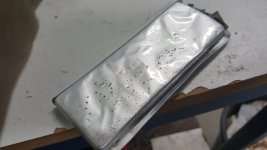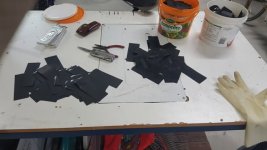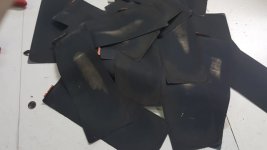jonescg
100 MW
Hey everyone,
I'm always keen to share a cool project, and I think this one is totally worth sharing.
I've probably built about 50 kWh worth of LiPo batteries since about 2011 when I first started playing with the stuff. My methods have improved and the results are very positive. I still cannot fault them for their ease of assembly, power and energy density. A LiPo battery of about 1 kWh capacity takes me about a half a day to put together. Now that I've developed the screw terminal system, they are even quicker to assemble and allows you to replace laggard cells should they arise.
A well built LiPo battery should last you about three years of daily use. The batteries in Voltron aren't putting out as much power as they used to, but they're good for all of this, and next season. But what happens when they're spent?
Well now that I have the screw terminal kit working you can probably replace low cells, but even then the pack will be more and more troublesome to re-purpose. At some point, you just have to give it to the LiPo gods . Or do we?
. Or do we?
LiPo, or lithium cobalt pouch cells for the hobby market, are basically a series of copper and aluminium leafs coated in a fine layer of lithium cobalt oxide, or LiCoO2 along with binding agents like PVDF and conductive special sauces like graphite, graphene and fine charcoal. These sheets of copper and aluminium form the current collectors, and are separated from each other by a polyethylene film. The stack is placed inside an aluminium foil lined pouch The copper electrodes and the aluminium electrodes are bunched together and resistance welded together. This is effectively how the cell gets its capacity - lots of plates in parallel. Nickel plated tabs are spot-welded to the bunch for final connections. A small volume of organic solvent is added to the pouch before being vacuum heat-sealed.
Copper, aluminium, lithium, cobalt and all the other special sauce ingredients were extracted from the earth and turned into very pure materials before being shoe-horned into your latest e-bike project, only to wind up like this:

(That spotty appearance is due to the cell having got wet at some point and galvanic corrosion of the foil is occurring. The cells may puff and if still charged, get mighty hot. But that's by the by, you don't want it any more).
Now, you can't re-purpose it, but you can recycle it. You could take your 1 kWh battery to Battery World and they will happily take it off you. They fill a sea container with them and ship them to China or India where they get 'recycled'; that is, dumped at sea, buried, burned or occasionally, put through an industrial waste sorter.
But we can do better than this.
***
I've started collecting people's unwanted LiPo cells and recycling them. I start by discharging the cells on a nichrome load. It's not necessary, but you get significantly less fire if you do 8)
Then I take a sharp knife and slit the cell open, pulling the polyethylene wrapped bundle out of the foil pouch and peeling it back like a foul-smelling solvent drenched banana. I pull the foil pouch away, ripping the tabs off as I go. At this stage I tear the copper and aluminium tab-bundles off. This helps prevent fires in the next step if the cells still have some charge left in them. The polyethylene wrapper is peeled back and unraveled. The copper leafs will be on one side and the aluminium on the other. Keep pulling them apart and separating the two metal leafs as you unravel the bundle. Soon you will have about 50 leaves each of coated copper and aluminium. The copper layer has mainly carbon and binders, but the aluminium layer has the LiCoO2 coated to it.

In this photo you can see where the cells were undergoing plating, or a break-down of the black special sauce and the formation of dry shiny spots. Probably why I'm recycling it and not riding with it.

Each cell takes me about 4.5 minutes to separate from the battery, cut open, separate the Cu and Al, and toss the polyethylene film in the bin. So the battery that took me half a day to build also takes half a day to recycle PROPERLY.
But, that's not all; metal recycling places don't like their copper or aluminum coated in LiCoO2 and carbon. So the next step is to dissolve the black shit off the surface of the leaf and pull clean metals out. The best solvent for this is an aprotic solvent like N-methyl pyrrolidone or DMSO. NMP is expensive, but really the best solvent for the job. It dissolves the polyvinyldiene fluoride (PVDF) which serves as a binding agent. This releases the lithium salts and carbon leaving clean metal.
The resulting black slurry can be reduced and the solvent re-collected on a rotovap. Now, the most relevant thing is to recycle the metals, but the lithium cobalt oxide and carbon can be recovered too.
http://www.sciencedirect.com/science/article/pii/S0378775300005231
These guys treated the resulting mixture with 4M HCl for an hour at 80'C. This produced a hot solution of various salts and carbon which could be filtered. The remaining solution was neutralised with NaOH causing Co(OH)2 to precipitate. This can be filtered and recovered. Cobalt salts are generally quite toxic, but they are also valuable, so hold onto them! The remaining solution will be a mixture of lithium and sodium chloride. Evaporation down to a salt will make lithium recovery easy too.
I'll be completing the process in the coming weeks and documenting the experience.
Sounds like a lot of work? Yeah well so is making the things, so the least you can do is recycle them!
I'm always keen to share a cool project, and I think this one is totally worth sharing.
I've probably built about 50 kWh worth of LiPo batteries since about 2011 when I first started playing with the stuff. My methods have improved and the results are very positive. I still cannot fault them for their ease of assembly, power and energy density. A LiPo battery of about 1 kWh capacity takes me about a half a day to put together. Now that I've developed the screw terminal system, they are even quicker to assemble and allows you to replace laggard cells should they arise.
A well built LiPo battery should last you about three years of daily use. The batteries in Voltron aren't putting out as much power as they used to, but they're good for all of this, and next season. But what happens when they're spent?
Well now that I have the screw terminal kit working you can probably replace low cells, but even then the pack will be more and more troublesome to re-purpose. At some point, you just have to give it to the LiPo gods
LiPo, or lithium cobalt pouch cells for the hobby market, are basically a series of copper and aluminium leafs coated in a fine layer of lithium cobalt oxide, or LiCoO2 along with binding agents like PVDF and conductive special sauces like graphite, graphene and fine charcoal. These sheets of copper and aluminium form the current collectors, and are separated from each other by a polyethylene film. The stack is placed inside an aluminium foil lined pouch The copper electrodes and the aluminium electrodes are bunched together and resistance welded together. This is effectively how the cell gets its capacity - lots of plates in parallel. Nickel plated tabs are spot-welded to the bunch for final connections. A small volume of organic solvent is added to the pouch before being vacuum heat-sealed.
Copper, aluminium, lithium, cobalt and all the other special sauce ingredients were extracted from the earth and turned into very pure materials before being shoe-horned into your latest e-bike project, only to wind up like this:

(That spotty appearance is due to the cell having got wet at some point and galvanic corrosion of the foil is occurring. The cells may puff and if still charged, get mighty hot. But that's by the by, you don't want it any more).
Now, you can't re-purpose it, but you can recycle it. You could take your 1 kWh battery to Battery World and they will happily take it off you. They fill a sea container with them and ship them to China or India where they get 'recycled'; that is, dumped at sea, buried, burned or occasionally, put through an industrial waste sorter.
But we can do better than this.
***
I've started collecting people's unwanted LiPo cells and recycling them. I start by discharging the cells on a nichrome load. It's not necessary, but you get significantly less fire if you do 8)
Then I take a sharp knife and slit the cell open, pulling the polyethylene wrapped bundle out of the foil pouch and peeling it back like a foul-smelling solvent drenched banana. I pull the foil pouch away, ripping the tabs off as I go. At this stage I tear the copper and aluminium tab-bundles off. This helps prevent fires in the next step if the cells still have some charge left in them. The polyethylene wrapper is peeled back and unraveled. The copper leafs will be on one side and the aluminium on the other. Keep pulling them apart and separating the two metal leafs as you unravel the bundle. Soon you will have about 50 leaves each of coated copper and aluminium. The copper layer has mainly carbon and binders, but the aluminium layer has the LiCoO2 coated to it.

In this photo you can see where the cells were undergoing plating, or a break-down of the black special sauce and the formation of dry shiny spots. Probably why I'm recycling it and not riding with it.

Each cell takes me about 4.5 minutes to separate from the battery, cut open, separate the Cu and Al, and toss the polyethylene film in the bin. So the battery that took me half a day to build also takes half a day to recycle PROPERLY.
But, that's not all; metal recycling places don't like their copper or aluminum coated in LiCoO2 and carbon. So the next step is to dissolve the black shit off the surface of the leaf and pull clean metals out. The best solvent for this is an aprotic solvent like N-methyl pyrrolidone or DMSO. NMP is expensive, but really the best solvent for the job. It dissolves the polyvinyldiene fluoride (PVDF) which serves as a binding agent. This releases the lithium salts and carbon leaving clean metal.
The resulting black slurry can be reduced and the solvent re-collected on a rotovap. Now, the most relevant thing is to recycle the metals, but the lithium cobalt oxide and carbon can be recovered too.
http://www.sciencedirect.com/science/article/pii/S0378775300005231
These guys treated the resulting mixture with 4M HCl for an hour at 80'C. This produced a hot solution of various salts and carbon which could be filtered. The remaining solution was neutralised with NaOH causing Co(OH)2 to precipitate. This can be filtered and recovered. Cobalt salts are generally quite toxic, but they are also valuable, so hold onto them! The remaining solution will be a mixture of lithium and sodium chloride. Evaporation down to a salt will make lithium recovery easy too.
I'll be completing the process in the coming weeks and documenting the experience.
Sounds like a lot of work? Yeah well so is making the things, so the least you can do is recycle them!


